 Mary rallying the crowd in Cradley Heath
Mary rallying the crowd in Cradley Heath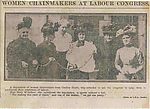 Women chainmakers deputation to Trade Union Congress
Women chainmakers deputation to Trade Union Congress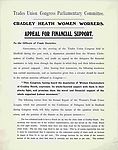 T.U.C appeal (p1)
T.U.C appeal (p1)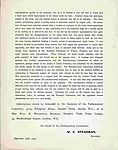 T.U.C. appeal (p.2)
T.U.C. appeal (p.2) Interview with Mary Macarthur
Interview with Mary Macarthur News report on Slaves of the Forge
News report on Slaves of the Forge 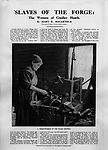 Slaves of the Forge by Mary Macarthur (p1)
Slaves of the Forge by Mary Macarthur (p1)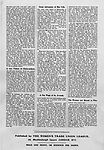 Slaves of the Forge by Mary Macarthur (p2)
Slaves of the Forge by Mary Macarthur (p2) News report on Slaves of the Forge
News report on Slaves of the Forge 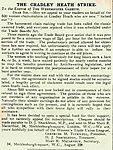 Newspaper appeal
Newspaper appeal German Trade unionist
German Trade unionist Moving pictures
Moving pictures

Mary Macarthur had been involved with National organisations dedicated to improving conditions for working women several years before the 1910 women chainmakers' strike in Cradley Heath. She had visited the area some three years earlier, at the time that she was involved in campaigning for the establishment of Trade Boards and a minimum wage. Mary was very active in the Cradley Heath area during the strike, but her real genius lay in bringing the cause of the women chainmakers to the attention of the whole country, and beyond. She gave interviews, wrote letters, addressed meetings and even used the new power of cinema to show music hall audiences what the chainmaker's life was like.
In 1909 the Trade Board Act set the minimum wage in chainmaking. It was the first trade to be dealt with under the act, but for six months, workers were allowed to contract out of the new rates. Certain employers took advantage of the delay and demanded, or tricked, women into signing exemptions from the new rates. They made their marks on the agreement and were shocked when it was explained to them what they had done. At the same time there was feverish activity to make chain at the cheap rates.
A new battle had to be fought. Mary predicted that, if women worked for six months outside the rates, employers would pile up stocks , and the work people afterwards would starve. They would dispense with workers on the new rate, giving the impression that the first effect of the new Act was to create unemployment and a slump.
Mary's plan was to mobilize the good employers. They agreed to pay the new rates if they could be safeguarded from being undercut by outside employers and the middlemen and women. There were 30 employers outside the Chainmakers' Association and about 150 contractors. The only way to guarantee that the good employers would not be undercut was to bring the women offered less than the rate out on strike. Many of them were not in a union and had no claim on union funds, so a strike for them would mean great hardship.
Nevertheless, Mary convinced the women that they should stand together and was intent on raising the funds to support them. It was a high risk strategy, for there was no way of knowing if the money would be forthcoming, but it was a typical example of Mary's drive, enthusiasm and confidence in the justice of the cause.
The first photograph reproduced here shows Mary addressing the strikers in Cradley Heath. She can see be seen standing in the middle of the crowd. She spoke at many such meetings and negotiated with the local employers, but perhaps her greatest strength was in drawing the attention of the nation to the plight of the chainmakers. When Mary left Cradley Heath to gather support, she left the strike organisation in the capable hands of Julia Varley and Charles Sitch.
Having been a part time journalist served Mary well. She gave the press detailed notes of all the meetings. "Journalists were learning to ring up Miss Macarthur if they wanted good copy: Miss Macarthur was constantly writing to the papers if she wanted a point rubbing in." (Hamilton, 1925, p48)) She gave many interviews, a report of one is reproduced here. Her famous "Slaves of the Forge" article, which first appeared in the "Christian Commonwealth" was quoted in newspapers throughout the land. Just two examples have been included here.
She organised a deputation of women chainmakers to the Trade Union Congress. Mary is third from the left in the photograph. The T.U.C. then circulated an appeal in support of the chainmakers, a copy of which is included. Also included is a copy of Mary's appeal, which appeared in many local and national newspapers.
Mary's success in publicizing the strike and its causes was not restricted to Great Britain. The Countess of Warwick, when in Cradley Heath to open a bazaar in 1912, said that she had heard of the women chainmakers, while she was in Australia. A German trade unionist, Herr Fritz Kummer, who said that he had travelled in Europe, America, Japan and China, had seen nothing as bad as Cradley. American industrialists, Dr and Mrs Andrews, visited Cradley Heath on their way to an International Congress in Lugane, in order to investigate the conditions under which the women worked.
Mary Macarthur was also busy making use of the power of cinema. A film of the chainmakers' strike, made by Pathe, was shown in over 500 music halls in London and the provinces. The manager of Pathe estimated that in two weeks about 10,000,000 people would have seen the film.
Not surprisingly, donations flooded in. On the night of the final conference, following a victory for the women chainmakers, wild applause greeted Mary, when she arrived. A few months later she returned to a gathering of over 2,000 people in Cradley Heath, where she was presented with a gold bracelet watch as a mark of their gratitude. Mary had "compelled the world to look at Cradley Heath as she saw it; she brought in countesses and ecclesiastics, charwomen and engine cleaners to share the struggle and suffering" of the chainmakers.(Hamilton, 1925, p95)
Rollover the captions in the box to see the available images in thumbnail format, click the caption to see the full-size image
| Reference: | 709 |
| Keywords: | |
| Archive Ref: | |
| Updated: | Thu 6 Sep 2007 - 12 |
| Interpretation written by | Barbara Harris |
| Author's organisation | |
| Organisation's website |